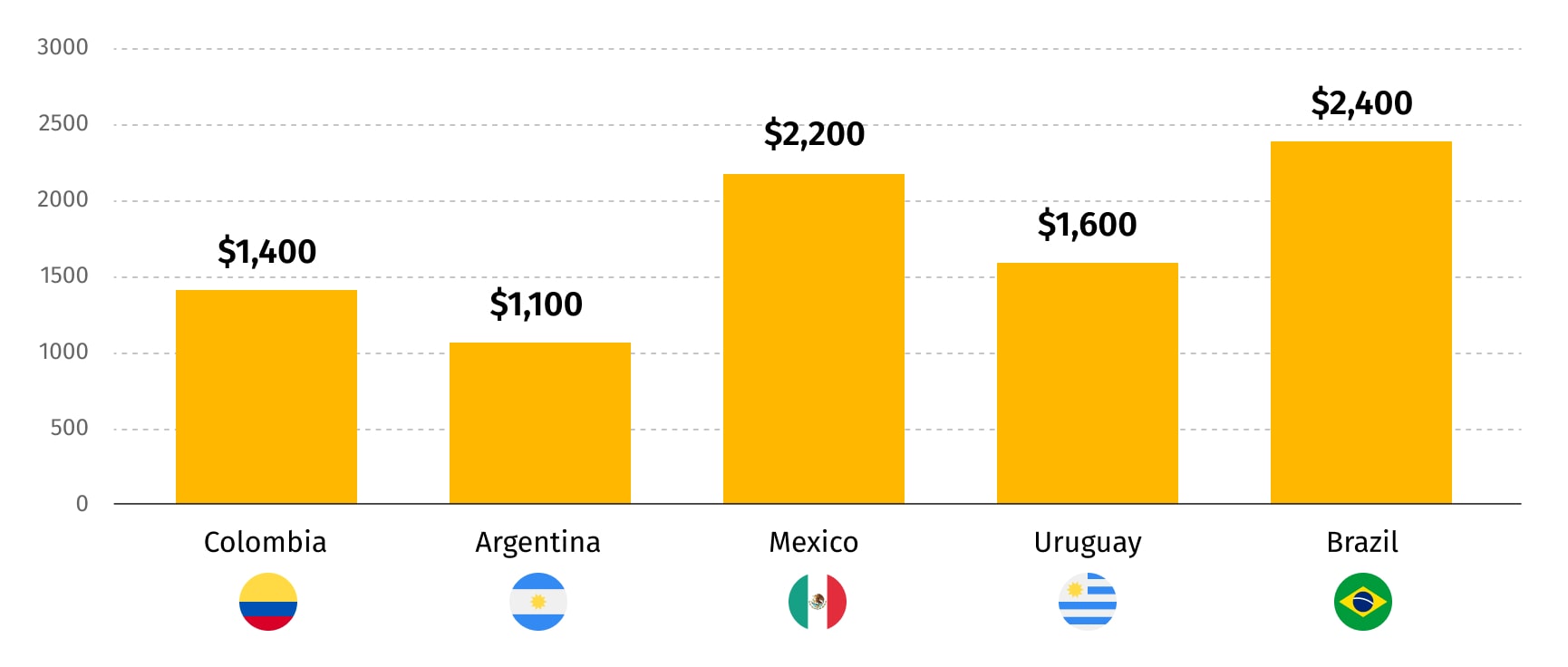The Cost of Hiring LatAm Developers in 2024
Table of Contents
The global recruitment of talent has become more prevalent, particularly among US tech companies. This trend is driven by the increasing demand for software developers coupled with rising hiring costs. As reported by Insider, US firms, leveraging remote work capabilities, are turning to international markets to streamline expenses. Notably, a significant 75% of US companies seeking software engineering talent are exploring avenues in Latin America, marking a notable 20% surge from the previous year and a striking 50% increase since the onset of the pandemic. This inclination towards global recruitment isn’t confined to US shores; in the Asia Pacific region alone, there has been a staggering 227% rise in employers seeking remote workers internationally in 2022. This surge reflects the growing trend to hire LatAm developers, highlighting the region’s attractiveness for companies seeking skilled software engineering talent.
Table of Contents
The appeal of hiring developers from international markets is evident. Regions like Latin America boast burgeoning tech industries with abundant pools of skilled professionals, often available at more competitive rates compared to their North American counterparts. For organizations striving to expand their teams through cost-effective means without compromising on code quality, these advantages are particularly enticing. When seeking to hire LatAm developers, companies can leverage these benefits to enhance their teams and drive innovation within their organizations.
However, with many emerging global markets, employers face the crucial decision of selecting the most suitable region for recruitment. Factors such as cost, skill proficiency, time zone alignment, and language proficiency come into play, making the decision-making process complex. In this article, we will look into the cost of hiring LatAm Developers in 2024.
1. Overview of the LatAm Developer Market
Latin America stands as a vibrant hub within the global tech landscape, boasting a diverse and rapidly expanding ecosystem of skilled software developers. Countries such as Brazil, Argentina, Colombia, and Mexico have witnessed substantial investments in their tech sectors, catalyzing a surge in IT education and training initiatives. Consequently, Latin American developers now showcase competencies and expertise that position them competitively on the world stage. For companies looking to hire LatAm developers, tapping into this talent pool can bring immense value and innovation to their projects.
The growth trajectory of the developer market in the region is remarkable, underpinned by escalating demand. Investments in tech infrastructure and education have yielded significant dividends, nurturing a talent pool adept at addressing diverse technological challenges. This surge in demand reflects the maturation of Latin America’s tech industry, with companies increasingly relying on local talent to drive innovation and development projects.
However, the allure of Latin America transcends the abundance of talent alone. Its geographical proximity to the United States, coupled with overlapping time zones, renders it an enticing option for startups seeking streamlined collaboration. This geographic advantage facilitates real-time communication and fosters a conducive environment for agile development cycles. Moreover, shared cultural affinities and a robust emphasis on English education in many LatAm nations further bolster communication channels, smoothing integration with US-based teams. This synergy enhances the appeal of hiring LatAm developers for startups aiming to optimize collaboration and accelerate their development processes.
However, the allure of Latin America transcends the abundance of talent alone. Its geographical proximity to the United States, coupled with overlapping time zones, renders it an enticing option for startups seeking streamlined collaboration. This geographic advantage facilitates real-time communication and fosters a conducive environment for agile development cycles. Moreover, shared cultural affinities and a robust emphasis on English education in many LatAm nations further bolster communication channels, smoothing integration with US-based teams.
For companies looking to hire LatAm developers, these factors underscore the region’s appeal as a strategic choice for fostering effective communication and collaboration within remote teams.
Latin America emerges as an indispensable resource for startups seeking to augment their development teams. Its burgeoning tech ecosystem, coupled with favorable geographic and cultural synergies, positions the region as a prime destination for accessing top-tier developer talent and driving innovation in the tech industry.
2. Factors Influencing the Cost of Hiring LatAm Developers
2.1 Labor Supply and Demand
The availability of developers in Latin America significantly influences the cost of hiring. As the demand for skilled software professionals escalates across various industries, particularly in tech hubs like Brazil, Argentina, Colombia, and Mexico, the competition for talent intensifies. In regions where the supply of developers outstrips demand, employers may enjoy more competitive rates. Conversely, in markets characterized by a shortage of skilled developers, wages tend to escalate as companies vie for limited talent pools, thereby driving up hiring costs.
This dynamic is essential for companies looking to hire LatAm developers as they navigate the complexities of talent acquisition in the region.
2.2. Skillset and Experience
The cost of hiring LatAm developers is also contingent upon their skillset and experience levels. Developers possessing specialized skills or extensive experience in high-demand technologies command premium rates. For instance, proficiency in emerging technologies such as blockchain, artificial intelligence, and machine learning often correlates with higher remuneration due to their scarcity and the complexity of associated projects. Conversely, developers with more generalized skill sets or junior-level experience may offer more cost-effective solutions, albeit with potential trade-offs in expertise and project complexity. When companies aim to hire LatAm developers, understanding the varying skill sets and experience levels is crucial for making informed decisions about resource allocation and project requirements.
2.3. Geographic Location

Geographic location within Latin America plays a pivotal role in determining hiring costs. Urban centers and tech hubs typically exhibit higher living costs, which are reflected in developer salaries. For instance, cities like São Paulo, Buenos Aires, and Bogotá often command higher wages compared to smaller cities or rural areas within the region. Additionally, factors such as local economic conditions, cost of living indices, and infrastructure development influence salary expectations, with developers in economically prosperous regions generally commanding higher compensation. Understanding these dynamics is essential when seeking to hire LatAm developers while balancing cost considerations with access to talent.
2.4. Industry and Technology Trends
The demand for specific skills or technologies within industries can significantly impact the cost of hiring LatAm developers. Industries experiencing rapid digital transformation or embracing cutting-edge technologies often face heightened competition for specialized talent, thereby driving up hiring costs.
For instance, sectors such as fintech, e-commerce, and healthcare are increasingly reliant on software solutions, resulting in heightened demand for developers proficient in relevant technologies. Consequently, developers with expertise in niche domains or emerging technologies may command premium rates due to their scarcity and strategic importance to industry trends. When looking to hire LatAm developers, understanding industry demand for particular skills can help businesses anticipate and manage hiring costs effectively.
3. Comparison of LatAm Developer Costs with Other Regions
To provide insights into the comparative costs of hiring developers in Latin America (LatAm) versus other popular outsourcing destinations, we analyzed hourly rates from different regions around the world. It is also necessary to understand the process of hiring LatAm developers to get a better understanding of comparing the cost of hiring developers in 2024.
| Region | Average Hourly Rate |
|---|---|
| United States | $82.50 |
| Canada | $77.00 |
| Western Europe | $76.50 |
| Eastern Europe | $57.25 |
| Southern Asia | $50.00 |
| Africa | $30.00 - $64.75 |
| Latin America | $45.00 - $55.00 |
Cost of hiring LatAm developers in 2024 | Scalable Path®
In the United States, freelance developers command the highest hourly rates, averaging $82.50 per hour, with rates escalating in tech-centric areas like San Francisco and New York. Canada and Western Europe exhibit comparable rates, averaging $77.00 and $76.50 per hour, respectively. However, companies looking to hire LatAm developers may find more cost-effective options without compromising quality, as developers from Latin America often offer competitive rates while delivering high-quality work.
Eastern Europe and Southern Asia have traditionally served as go-to destinations for remote talent, offering sizable talent pools at relatively affordable rates. While Eastern Europe’s prices align more closely with Latin America’s, hiring from these regions may pose communication and time zone challenges, particularly for US-based companies.
Considering these factors, US-based companies may find it advantageous to hire LatAm developers due to closer time zones and cultural proximity, facilitating smoother communication and collaboration. Additionally, Latin America offers a growing pool of skilled developers who are proficient in various technologies, making it an attractive option for companies seeking to augment their remote teams.
Africa emerges as an emerging market for software talent, with hourly rates ranging from $30.00 to $64.75. Despite affordable rates, challenges such as connectivity issues and minimal time zone overlap with North America may hinder collaboration for companies in the region.
Compared on a global scale, Latin America stands out as an attractive option for US companies seeking talent sourcing. While LatAm’s hourly rates are higher on average than those in Asia and Africa, they remain substantially lower than those in the United States, Canada, and Australia. Moreover, the significant time zone overlap and relatively similar work culture between Latin America and the US foster smoother collaboration, enhancing overall project success. Given these advantages, our team has prioritized building a strong network presence in the LatAm region.
4. Cost Range for Hiring LatAm Developers
Eastern Europe and Southern Asia have traditionally served as go-to destinations for remote talent, offering sizable talent pools at relatively affordable rates. While Eastern Europe’s prices align more closely with Latin America’s, hiring from these regions may pose communication and time zone challenges, particularly for US-based companies.
When considering where to hire remote developers, businesses should also explore the option to hire LatAm developers. Latin America offers competitive rates, similar to Eastern Europe, while potentially mitigating communication and time zone issues for US companies. This strategic move can enhance collaboration and streamline workflows, ensuring effective remote team dynamics.
#Brazil:

Brazil has experienced significant growth in its startup ecosystem, bolstered by multi-billion dollar investments in the tech sector. The hourly rates for developers in Brazil can range from moderate to higher end, reflecting the country’s thriving tech scene and increasing proficiency in technology skills. This makes Brazil an attractive option for companies looking to hire LatAm developers, leveraging the country’s burgeoning tech landscape and skilled workforce.
#Argentina:
With advancements in its startup ecosystem and notable English proficiency, Argentina offers competitive rates for hiring developers. The cost range in Argentina is influenced by factors such as English proficiency levels and the quality of education in technology fields. For companies looking to hire LatAm developers, Argentina presents an attractive option due to its combination of affordability and skilled talent.
#Colombia:
Colombia boasts one of the most robust startup ecosystems in Latin America, supported by substantial investments in science and technology. The hourly rates for developers in Colombia vary, influenced by the country’s growing tech industry and the level of skill proficiency among IT professionals. When looking to hire LatAm developers, exploring Colombia’s thriving tech scene can provide access to skilled professionals at competitive rates.
#Mexico:
As one of the largest economies in Latin America, Mexico has a thriving tech scene, particularly in cities like Guadalajara, which has emerged as a top tech hub. The hourly rates for developers in Mexico range from moderate to high, reflecting the country’s increasing technology proficiency and the concentration of IT professionals in key urban centers. When looking to hire LatAm developers, Mexico stands out as a promising destination due to its vibrant tech ecosystem and skilled workforce.
#Other Countries:
Countries such as Uruguay, Peru, and Chile may not be the largest in Latin America, but they offer concentrated talent pools and competitive hourly rates comparable to the rest of the region. However, access to larger talent pools in countries like Brazil, Chile, and Colombia may offer advantages in terms of finding candidates more quickly and efficiently.
When seeking to hire LatAm developers, businesses should consider factors such as the size of the talent pool and the competitiveness of hourly rates across different countries. This allows for strategic decision-making in finding the right talent for software development projects.
5. Salary of LatAM Developers
According to Grid Dynamics, Columbia stands out as the country paying the highest annual salary for developers in LatAm. The following diagram is an illustration from Grid Dynamics. It shows the annual salaries of software developers in different LatAm. Obtaining a clear idea about how the annual salaries are distributed allows you to grasp the cost of hiring LatAm developers.
Furthermore, talently.tech gives a further explanation about the break of the annual salaries of LatAm developers.
- Panama: Senior developers typically earn an average of $2,250 per month, with potential earnings reaching up to $3,500 depending on various factors, as reported by Computrabajo.com. Junior developers, on the other hand, typically earn between $1,000 and $1,800 monthly. These salary ranges provide valuable insights for businesses looking to hire LatAm developers, helping them understand the compensation expectations within the region’s talent pool. When looking to hire LatAm developers, understanding these salary expectations can aid in budgeting and negotiating competitive compensation packages.
- Chile: According to the Robert Half 2021 salary guide, Full-Stack Developers, the highest specialization in the field, earn between $1,600 and $2,100 per month in Chile.
- Brazil: With a significant developer community and a focus on video game development, salaries for Senior Programmers in São Paulo range from around $1,000 to $1,800, as reported by Glassdoor.
- Peru: Junior developers in Peru earn an average of about $580 per month, according to Computrabajo.com and Glassdoor.
- Uruguay: Glassdoor reports that Full Stack Developers in Uruguay earn an average of $1,500 per month, with a strong emphasis on cybersecurity in the country’s technology sector. This information can be valuable for companies looking to hire LatAm developers, as it provides insights into salary expectations and industry focus within specific countries.
- Mexico: The average salary for programmers in Mexico is $1,600 per month, as reported by Indeed. CodersLink indicates that the majority of reported salaries are above this figure.
- Argentina: In Buenos Aires, programmer salaries vary between $450 and $2,300, according to the Adecco 2022-2023 salary guide cited by bloomberglinea.com.
- Colombia: Tech professionals in Colombia earn an average salary of about $1,300 per month, based on data from Indeed.co.
- Venezuela: Hispanogeeks reports that Venezuelan developers earn an average of $1,200 per month.
- Costa Rica: Glassdoor indicates that programmers in Costa Rica earn an average salary of $12,000 per year.
- Ecuador: The average monthly salary for developers in Ecuador is $519, according to data from Computrabajo.
6. Factors Contributing to Varying Costs:
- Skill Proficiency
– Higher proficiency in technology skills leads to higher developer rates.
– Countries with advanced tech ecosystems often produce developers with sought-after skills, commanding higher rates.
– Skill proficiency is influenced by factors such as the quality of education, availability of training programs, and industry experience.
- Economic Factors
– Economic conditions greatly impact developer rates, with countries experiencing strong economic growth typically charging higher rates.
– Government investments in the tech sector can stimulate growth and innovation, affecting developer rates.
– Currency exchange rates also play a role, with stronger currencies often resulting in higher costs for hiring developers.
- Educational Infrastructure
– The quality of education in technology fields directly affects the skill level of developers and, consequently, their rates.
– Countries with well-established tech education systems and specialized training programs tend to produce more skilled professionals.
– Investments in STEM (Science, Technology, Engineering, and Mathematics) education can lead to a larger pool of qualified developers, influencing market rates.
- Market Competition
– The level of competition within the tech industry and the availability of talent pools influence developer rates.
– Countries with highly competitive tech markets may offer lower rates as developers compete for projects.
– Access to diverse talent pools, including freelancers, remote workers, and outsourcing companies, can affect pricing dynamics.
While the cost range for hiring developers in Latin America varies across countries, several factors contribute to this variance. Understanding the interplay of skill proficiency, economic conditions, educational infrastructure, and market competition is essential for businesses seeking to optimize their hiring strategies and leverage the diverse talent pool available in the region. By considering these factors, companies can make informed decisions to meet their development needs effectively while managing costs efficiently. This approach is crucial when seeking to hire LatAm developers and maximize the value of talent investments in the region.
7. Additional Considerations in Hiring LatAm Developers
When hiring developers from Latin America, several additional considerations beyond technical expertise and cost must be taken into account to ensure successful collaboration and project outcomes. These considerations encompass language and communication skills, cultural compatibility, and the management of time zone differences.
7.1. Language and Communication Skills:
- Language proficiency, particularly in English, is crucial for effective communication between the hiring company and developers from Latin America.
- Clear and efficient communication channels facilitate understanding project requirements, addressing concerns promptly, and fostering collaboration.
- Assessing language proficiency during the hiring process helps ensure that developers can effectively communicate with team members and stakeholders.
7.2. Cultural Compatibility:
- Cultural compatibility plays a significant role in the success of collaborative projects involving developers from Latin America.
- Understanding cultural nuances, work practices, and communication styles fosters a harmonious working relationship and enhances team cohesion.
- Recognizing and respecting cultural differences in work attitudes, hierarchy, and decision-making processes is essential for building strong and productive teams.
7.3. Time Zone Differences:
- Working with developers in different time zones presents both challenges and opportunities.
- Time zone variances can lead to scheduling conflicts, delays in communication, and coordination challenges, requiring careful management.
- However, leveraging time zone differences can enable round-the-clock development and potentially faster project turnaround times.
- Implementing effective project management strategies, such as overlapping working hours, asynchronous communication tools, and clear task delegation, can help mitigate the challenges posed by time zone disparities.
When hiring developers from Latin America, it’s essential to consider factors beyond technical skills and cost. Assessing language and communication proficiency, ensuring cultural compatibility, and effectively managing time zone differences are critical for fostering successful collaboration and achieving project objectives.
By addressing these additional considerations, companies can build strong, cohesive teams and navigate the complexities of working with developers across geographical boundaries more effectively.
8. Benefits of Hiring LatAm Developers
Hiring developers from Latin America (LatAm) offers a plethora of benefits for companies seeking to augment their technical teas.
- Cost-Effectiveness: Latin American developers often offer competitive rates compared to their counterparts in North America and Western Europe. This cost-effectiveness enables companies to access top-tier talent without breaking the bank, making it an attractive option for startups and small to medium-sized enterprises (SMEs) with budget constraints. This is one of the top reasons why you should consider hiring LatAm developers.
- Skilled Talent Pool: Latin America boasts a burgeoning tech ecosystem with a rich pool of skilled developers. Countries like Brazil, Argentina, Colombia, and Mexico have witnessed significant investments in technology education and training programs, resulting in a talent pool proficient in a wide range of programming languages, frameworks, and technologies.
- Cultural Affinity and Collaboration: Latin America shares cultural affinities with North America, making collaboration between LatAm developers and US-based teams smoother and more seamless. Shared values, work ethics, and communication styles contribute to better integration and teamwork, enhancing overall project success.
- Time Zone Compatibility: Many LatAm countries share overlapping time zones with North America, facilitating real-time communication and collaboration. This alignment minimizes communication barriers and delays, enabling agile development cycles and faster project delivery.
- English Proficiency: English proficiency is on the rise in Latin America, with many developers fluent or proficient in English. This language proficiency simplifies communication with clients and team members from English-speaking countries, eliminating language barriers and ensuring clarity in project requirements and objectives.
- Proximity to the United States: Latin America’s geographical proximity to the United States makes it an attractive outsourcing destination for US companies. Short travel distances and time zones make it easier for companies to visit development teams, conduct on-site meetings, and build stronger working relationships.
- Innovation and Creativity: Latin America is a hotbed of innovation and creativity, with vibrant startup ecosystems and a culture of entrepreneurship. Hiring LatAm developers exposes companies to fresh perspectives, innovative ideas, and creative problem-solving approaches, driving innovation within the organization.
- Diverse Skill Sets: Latin America offers a diverse range of skill sets and expertise, allowing companies to find developers with specialized knowledge and experience tailored to their specific project requirements. Whether it’s web development, mobile app development, data science, or AI, LatAm developers bring diverse skill sets to the table.
Hiring developers from Latin America presents numerous benefits, including cost-effectiveness, access to skilled talent, cultural affinity, time zone compatibility, English proficiency, proximity to the United States, innovation, and diverse skill sets. These advantages make Latin America an attractive outsourcing destination for companies looking to build high-performing development teams and drive business growth.
9. Conclusion
In this article, we have explored the landscape of hiring developers from Latin America (LatAm) in 2024, shedding light on the various factors influencing the decision-making process for companies seeking to augment their technical teams.
A comparison of the cost of hiring LatAm developers with other popular outsourcing destinations revealed the region’s competitive advantage in terms of cost-effectiveness, skill proficiency, and collaboration potential. We delved into the specific cost ranges for hiring developers in different LatAm countries, emphasizing factors such as skill proficiency, economic conditions, educational infrastructure, and market competition.
CloudDevs is your go-to platform to hire LatAm developers. With over 8000+ developers and designers, CloudDevs brings a talent pool across Latin America.
In conclusion, the cost of hiring LatAm developers in 2024 offers a compelling value proposition for companies worldwide. With competitive rates, a diverse talent pool, and favorable cultural and logistical factors, Latin America continues to emerge as a preferred destination for sourcing top-tier developer talent. By leveraging the advantages of hiring from LatAm, companies can effectively scale their technical teams, drive innovation, and achieve business objectives in an increasingly competitive global marketplace.








